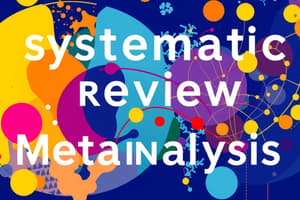Podcast
Questions and Answers
What does a relative risk (RR) of 1 indicate?
What does a relative risk (RR) of 1 indicate?
- No increased risk therefore no association (correct)
- Significant statistical difference
- Decreased risk and negative association
- Increased risk and positive association
What is indicated by an odds ratio (OR) greater than 1?
What is indicated by an odds ratio (OR) greater than 1?
- Exposure is positively associated with disease (correct)
- No association between exposure and disease
- Statistically significant difference
- Exposure is negatively associated with disease
What is a characteristic of selection bias?
What is a characteristic of selection bias?
- It affects the measurement of actual outcomes
- It involves misclassification of data
- It results from volunteer sampling methods (correct)
- It occurs from incorrect reporting of outcomes
Why can relative risk not be performed with a case-control study?
Why can relative risk not be performed with a case-control study?
What does internal validity refer to?
What does internal validity refer to?
What is the relationship between rate ratios and risk ratios for rare diseases?
What is the relationship between rate ratios and risk ratios for rare diseases?
How can confounding variables affect research?
How can confounding variables affect research?
What does a P value greater than 0.005 indicate?
What does a P value greater than 0.005 indicate?
What is a primary advantage of conducting a systematic literature review compared to individual studies?
What is a primary advantage of conducting a systematic literature review compared to individual studies?
Which of the following is NOT a prerequisite for conducting a meta-analysis?
Which of the following is NOT a prerequisite for conducting a meta-analysis?
Which statistical method is suitable for both binary and continuous data in meta-analysis?
Which statistical method is suitable for both binary and continuous data in meta-analysis?
In which scenarios should the Mantel-Haenszel method be used?
In which scenarios should the Mantel-Haenszel method be used?
What is the fundamental assumption of the fixed effects model in meta-analysis?
What is the fundamental assumption of the fixed effects model in meta-analysis?
Which of the following statements about the random effects model in meta-analysis is true?
Which of the following statements about the random effects model in meta-analysis is true?
Under which condition would Peto's method be appropriate in a meta-analysis?
Under which condition would Peto's method be appropriate in a meta-analysis?
What does testing the fixed effects assumption with a test of homogeneity help determine?
What does testing the fixed effects assumption with a test of homogeneity help determine?
What does sensitivity measure in diagnostic accuracy studies?
What does sensitivity measure in diagnostic accuracy studies?
Which statement best describes specificity in diagnostic tests?
Which statement best describes specificity in diagnostic tests?
Why is the Positive Predictive Value (PPV) important in diagnostic tests?
Why is the Positive Predictive Value (PPV) important in diagnostic tests?
What does a high sensitivity test imply?
What does a high sensitivity test imply?
In health economic evaluations, what is the primary goal?
In health economic evaluations, what is the primary goal?
Which of the following factors does NOT affect Positive Predictive Value (PPV)?
Which of the following factors does NOT affect Positive Predictive Value (PPV)?
What is a diagnostic accuracy study primarily concerned with?
What is a diagnostic accuracy study primarily concerned with?
Which term describes the ability of a test to correctly identify individuals without a condition?
Which term describes the ability of a test to correctly identify individuals without a condition?
In the Markov model, which health state is considered an absorbing state?
In the Markov model, which health state is considered an absorbing state?
Which transition probability from the sick state is highest?
Which transition probability from the sick state is highest?
Which statement best describes the relationship between rates and probabilities in health modeling?
Which statement best describes the relationship between rates and probabilities in health modeling?
How should probabilities be transformed to adjust or convert them into rates?
How should probabilities be transformed to adjust or convert them into rates?
What is meant by the term 'deterministic decision analysis' (DDA)?
What is meant by the term 'deterministic decision analysis' (DDA)?
What is primarily determined by the physician-patient decision process in healthcare?
What is primarily determined by the physician-patient decision process in healthcare?
Which type of study design is ranked highest in the hierarchy of evidence development?
Which type of study design is ranked highest in the hierarchy of evidence development?
In the context of health economic modeling, what is the primary purpose of a meta-analysis?
In the context of health economic modeling, what is the primary purpose of a meta-analysis?
What defines whether a drug is considered too expensive?
What defines whether a drug is considered too expensive?
Which of the following statements about the Markov model is correct?
Which of the following statements about the Markov model is correct?
When assessing the cost-effectiveness of a drug, which aspect is typically uncertain?
When assessing the cost-effectiveness of a drug, which aspect is typically uncertain?
What is the first step in developing a value dossier for pharmaceutical assessment?
What is the first step in developing a value dossier for pharmaceutical assessment?
What does the memoryless property in a Markov model imply?
What does the memoryless property in a Markov model imply?
Study Notes
Systematic Review
- Larger sample size than individual studies allows for subgroup analysis.
- Results of systematic reviews are more accurate than individual studies due to larger sample size.
- Meta-analysis is a specific type of systematic review that uses quantitative assessment of outcome parameters.
Meta-Analysis
- Not all systematic reviews include a meta-analysis.
- Requires studies to include (approximately) the same intervention, patient population, and outcome measures.
- Studies must meet acceptable methodological quality standards.
- Three statistical methods for meta-analysis: Inverse Variance-weighted method, Mantel-Haenszel, and Peto.
Inverse Variance-weighted Method (IV)
- Suitable for all outcome measures (OR, RR, RD, MD, etc.).
- Applicable for both binary and continuous data.
Mantel-Haenszel (MH)
- Used when data is sparse (low event rates and small trials).
- Only suitable for binary outcomes.
Peto
- Suitable for odds ratios and when the event of interest is rare.
- Not suitable for large treatment effects
Fixed Effects Model
- Assumes a fixed treatment effect (same value in each study).
- Differences in results are attributed to chance.
- Assumes studies estimate the same effect size.
- Requires testing the fixed effects assumption with a test of homogeneity.
Random Effects Model
- Assumes effect sizes may differ.
- Differences in results are not purely due to chance.
- Incorporates more uncertainty.
- DerSimonian and Laird method is used to incorporate heterogeneity.
- Confidence intervals in random effects models are wider than fixed effects models.
Relative Risk (RR)
- Two types: risk ratio and rate ratio. = 1: No increased risk, no association.
-
1: Increased risk, positive association.
- < 1: Decreased risk, negative association.
- Reported along with a p-value.
- Cannot be performed with case-control studies.
Odds Ratio (OR)
- Used in both cohort and case-control studies. = 1: Exposure not associated with disease.
-
1: Exposure positively associated with disease.
- <1: Exposure negatively associated with disease.
- Rate Ratios and Risk Ratios are similar for rare diseases.
Bias
- Systematic error that leads to incorrect conclusions about the true effect of an exposure on an outcome.
- Undermines the internal validity of research.
- Selection bias: Results from differences in study groups in important aspects (sampling, attrition, volunteer).
- Information Bias: Misclassification or inaccurate reporting of information (reporting, recall, observer).
Confounding Variable
- Real but misleading associations.
- Related to both the cause and effect of the study.
- Stratification can be used to reduce the impact of confounding variables.
Internal and External Validity
- Internal validity: Whether the conclusions about the cause and effect relationship in a study are valid.
- External Validity: The extent to which study results can be generalized to another context.
Sensitivity and Specificity
- Measures of the accuracy of a diagnostic test.
- Sensitivity: Ability of a test to correctly identify individuals with the condition.
- Specificity: Ability of a test to correctly identify individuals without the condition.
- Positive Predictive Value (PPV): Likelihood that someone with a positive test result has the condition.
Positive Predictive Value (PPV)
- Probability someone with a positive test result actually has condition.
- High sensitivity screening tests (low false negatives).
- High specificity confirmatory tests (low false positives).
Health Economic Evaluations
- Comparative analysis of two or more alternative investment possibilities (interventions, strategies, policies).
- Goal is to identify, measure, value, and compare costs and consequences of alternatives.
Types of Healthcare Decisions
- Market Approval Decisions (EU Regulation)
- Market Access and Pricing Decisions (Companies)
- Reimbursement of New Pharmaceuticals and Medical Devices (Ministers of Health, National Insurance)
- Physician Decisions about Medical Treatments (Physician/Patient)
Hierarchy of Evidence Development
- IV: Expert Opinions
- III: Non-experimental Studies
- IIb: Quasi-experimental Studies
- IIa: Controlled Studies without Randomization
- Ib: Well-Performed RCTs
- Ia: Systematic Reviews of Well-Performed RCTs
Market Authorization
- Process of evaluating the safety and efficacy of drugs, etc.
Development of a Value Dossier
- Collecting and synthesizing evidence for the cost-effectiveness of a treatment.
Requesting Reimbursement
- Considerations include: budget, affordability, pricing, access, and return on investment.
Markov Model
- Mathematical model that simulates the progression of individuals or systems through various states over time.
- Key Components:
- Mutually Exclusive: Only one state at a time.
- Cycle: Individuals move between states at each time period.
- Transition Probabilities: Likelihood of moving from one state to another.
- Memoryless Property: Transition probabilities depend only on the current state.
- Example: A simple chronic disease can be modeled with health states (Healthy, Sick, Dead), transition probabilities (moving between states), cycle length, and costs/utilities for each state.
Deterministic Decision Analysis (DDA)
- Uses mean values for each input parameter, assuming exact values are known.
Studying That Suits You
Use AI to generate personalized quizzes and flashcards to suit your learning preferences.
Related Documents
Description
This quiz covers the essential concepts of systematic reviews and meta-analyses, focusing on different methods used in the analysis. You will learn about the importance of larger sample sizes, subgroup analysis, and the specific statistical methods for conducting a meta-analysis. Understand the distinctions and applications of the Inverse Variance-weighted method, Mantel-Haenszel, and Peto methods.





